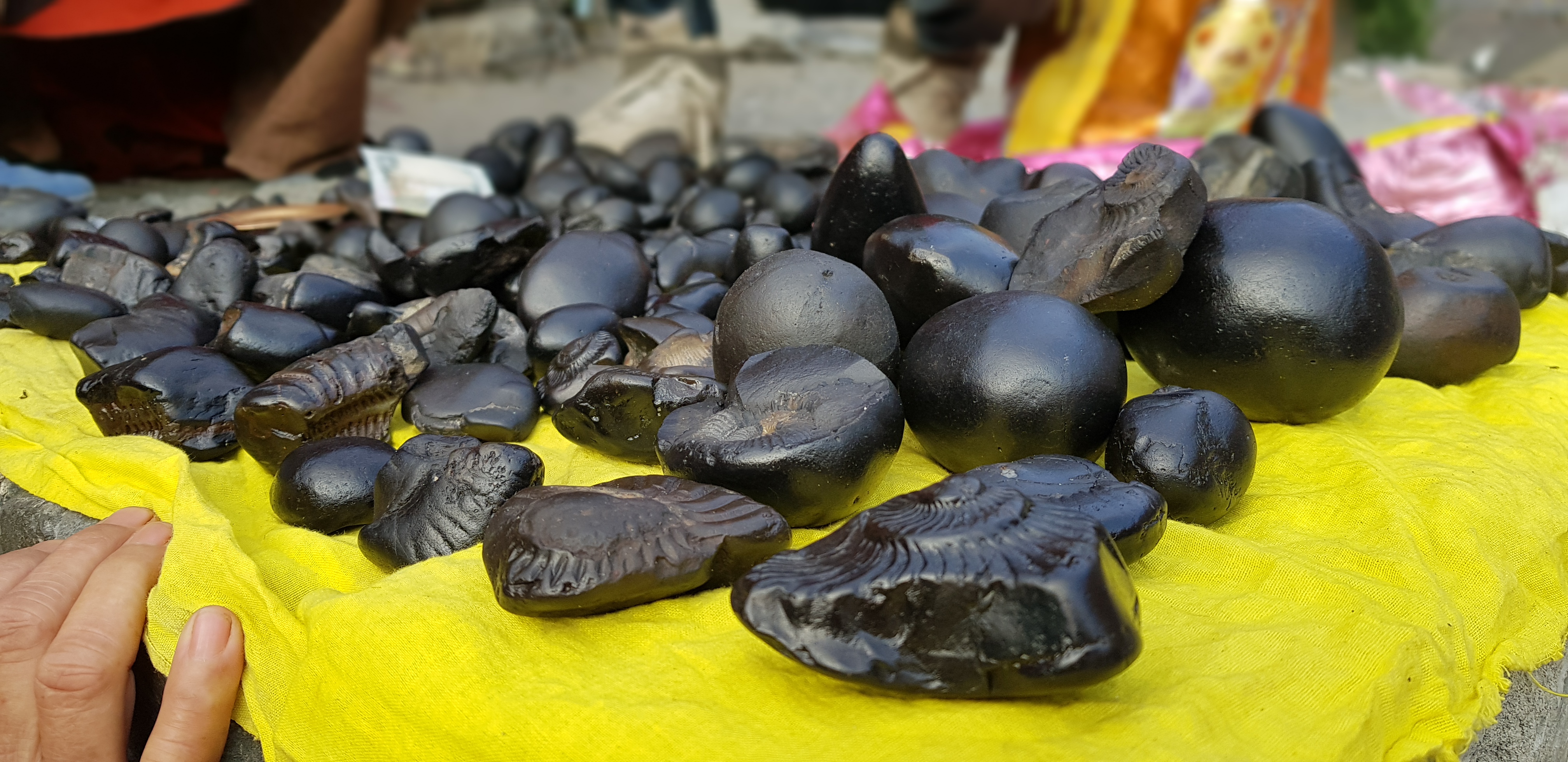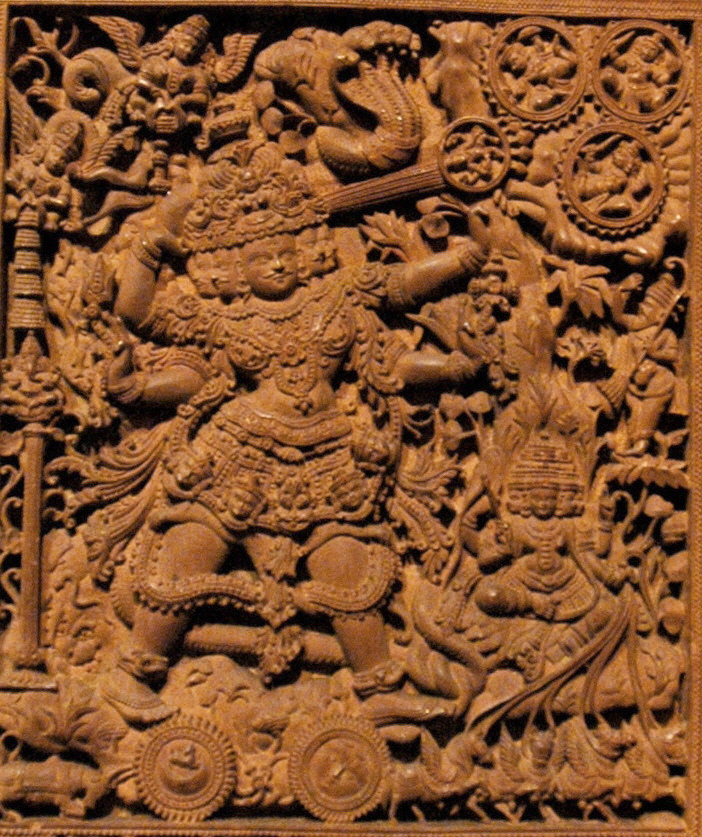|
Tulasi Chaura
A Tulasi Vrindavana () is a small podium-like stone or cement altar present in front of traditional Hindu houses, housing the sacred tulasi plant. Tulasi is an aromatic plant in the family Lamiaceae, native throughout the tropics, and widespread as a cultivated plant and an escaped weed. The structure is also known as Tulasi Thara (Malayalam: തുളസിത്തറ), Tulasi Chaura or Tulasi Vrindavan (), Tulasi Brindavanam (), and Tulasi Brundavanam (Telugu: తులసి బృందావనం) in Indian regional languages. Significance Hindu literature personifies the tulasi plant as the goddess Tulasi. According to a legend from the Brahma Vaivarta Purana, Saraswati, Ganga, and Lakshmi were the three wives of the preserver deity, Vishnu. An argument once ensued between a resentful Saraswati and Ganga, with the latter being accused of trying to get too close to their common husband. Lakshmi attempted to pacify both of them, but in the ensuing quarrel, the three of ... [...More Info...] [...Related Items...] OR: [Wikipedia] [Google] [Baidu] |
Shiva
Shiva (; sa, शिव, lit=The Auspicious One, Śiva ), also known as Mahadeva (; ɐɦaːd̪eːʋɐ, or Hara, is one of the principal deities of Hinduism. He is the Supreme Being in Shaivism, one of the major traditions within Hinduism. Shiva is known as "The Destroyer" within the Trimurti, the Hindu trinity which also includes Brahma and Vishnu. In the Shaivite tradition, Shiva is the Supreme Lord who creates, protects and transforms the universe. In the goddess-oriented Shakta tradition, the Supreme Goddess ( Devi) is regarded as the energy and creative power (Shakti) and the equal complementary partner of Shiva. Shiva is one of the five equivalent deities in Panchayatana puja of the Smarta tradition of Hinduism. Shiva has many aspects, benevolent as well as fearsome. In benevolent aspects, he is depicted as an omniscient Yogi who lives an ascetic life on Mount Kailash as well as a householder with his wife Parvati and his three children, Ganesha, Kartikeya and A ... [...More Info...] [...Related Items...] OR: [Wikipedia] [Google] [Baidu] |
Kerala
Kerala ( ; ) is a state on the Malabar Coast of India. It was formed on 1 November 1956, following the passage of the States Reorganisation Act, by combining Malayalam-speaking regions of the erstwhile regions of Cochin, Malabar, South Canara, and Thiruvithamkoor. Spread over , Kerala is the 21st largest Indian state by area. It is bordered by Karnataka to the north and northeast, Tamil Nadu to the east and south, and the Lakshadweep Sea to the west. With 33 million inhabitants as per the 2011 census, Kerala is the 13th-largest Indian state by population. It is divided into 14 districts with the capital being Thiruvananthapuram. Malayalam is the most widely spoken language and is also the official language of the state. The Chera dynasty was the first prominent kingdom based in Kerala. The Ay kingdom in the deep south and the Ezhimala kingdom in the north formed the other kingdoms in the early years of the Common Era (CE). The region had been a prominent spic ... [...More Info...] [...Related Items...] OR: [Wikipedia] [Google] [Baidu] |
India
India, officially the Republic of India (Hindi: ), is a country in South Asia. It is the seventh-largest country by area, the second-most populous country, and the most populous democracy in the world. Bounded by the Indian Ocean on the south, the Arabian Sea on the southwest, and the Bay of Bengal on the southeast, it shares land borders with Pakistan to the west; China, Nepal, and Bhutan to the north; and Bangladesh and Myanmar to the east. In the Indian Ocean, India is in the vicinity of Sri Lanka and the Maldives; its Andaman and Nicobar Islands share a maritime border with Thailand, Myanmar, and Indonesia. Modern humans arrived on the Indian subcontinent from Africa no later than 55,000 years ago., "Y-Chromosome and Mt-DNA data support the colonization of South Asia by modern humans originating in Africa. ... Coalescence dates for most non-European populations average to between 73–55 ka.", "Modern human beings—''Homo sapiens''—originated in Africa. Then, int ... [...More Info...] [...Related Items...] OR: [Wikipedia] [Google] [Baidu] |
Chaturmas
Chaturmasya ( sa, चातुर्मास्य, lit=Cāturmāsya), also rendered Chāturmāsa, is a holy period of four months, beginning on Shayani Ekadashi—the eleventh day of the bright half, Shukla paksha, of Ashadha (fourth month of the Hindu lunar calendar)—until Prabodhini Ekadashi, the eleventh day of the bright half of '' Kartika'' (eighth month of the Hindu lunar calendar) in Hinduism. Chaturmasya is reserved for penance, austerities, fasting, bathing in holy rivers and religious observances for all. Devotees resolve to observe some form of vow, be it of silence or abstaining from a favourite food item, or having only a single meal a day. Etymology Chaturmasya literally means "four months", derived from the Sanskrit ''catur'' (चतुर्), "four", and ''māsa'' (मासः), "month". Zodiac Interpretation The sun enters the zodiacal sign of Karka (Cancer) and begins to move southwards in the month of Ashadh. Hinduism The eleventh day of Ashadha is ca ... [...More Info...] [...Related Items...] OR: [Wikipedia] [Google] [Baidu] |
Hindu Wedding
A Hindu wedding, also known as Vivaha (Devanagari: विवाह; Kannada script: ವಿವಾಹ; ''Vivaaha'') (), Lagna (लग्न), or Kalyanam (Devanagari: कल्याणम्; Kannada script: ಕಲ್ಯಾಣಮ್; ta, கல்யாணம்), is the traditional wedding ceremony for Hindus. The wedding ceremonies are very colourful, and celebrations may extend for several days. The bride's and groom's home—entrance, doors, wall, floor, roof—are sometimes decorated with colors, flowers, and other decorations.Yee, A. (2008 May 17Sari nights and henna parties ''The Financial Times''. The word ''vivāha'' originated as a sacred union of people as per Vedic traditions, i.e. what many call marriage, but based on cosmic laws and advanced ancient practices. Under Vedic Hindu traditions, marriage is viewed as one of the saṁskāras, which are lifelong commitments of one wife and one husband. In India, marriage has been looked upon as having been designed by the ... [...More Info...] [...Related Items...] OR: [Wikipedia] [Google] [Baidu] |
Rama
Rama (; ), Ram, Raman or Ramar, also known as Ramachandra (; , ), is a major deity in Hinduism. He is the seventh and one of the most popular '' avatars'' of Vishnu. In Rama-centric traditions of Hinduism, he is considered the Supreme Being. Rama is said to have been born to Kaushalya and Dasharatha in Ayodhya, the ruler of the Kingdom of Kosala. His siblings included Lakshmana, Bharata, and Shatrughna. He married Sita. Though born in a royal family, their life is described in the Hindu texts as one challenged by unexpected changes such as an exile into impoverished and difficult circumstances, ethical questions and moral dilemmas. Of all their travails, the most notable is the kidnapping of Sita by demon-king Ravana, followed by the determined and epic efforts of Rama and Lakshmana to gain her freedom and destroy the evil Ravana against great odds. The entire life story of Rama, Sita and their companions allegorically discusses duties, rights and social responsibil ... [...More Info...] [...Related Items...] OR: [Wikipedia] [Google] [Baidu] |
Shaligram
A shaligrama shila ( deva, शालिग्राम शिला, Śāligrāma-śilā), also rendered as shaligram, is a particular variety of stone collected from riverbed or banks of the Kali Gandaki, a tributary of the Gandaki River in Nepal, used as a non-anthropomorphic representation of God Vishnu by Hindus. They are typically fossils of ammonite shells from the Devonian-Cretaceous period of 400 to 66 million years ago. The fossils are considered holy by Hindus because Madhvacharya received it from Vyasadeva, also called Astamurti, and also they resemble symbols associated with God Vishnu, mainly the Shankha (conch shell). Legends According to the Devi Bhagavata Purana, Brahmavaivarta Purana, and Shiva Purana, shilagrama shilas originated due to the following chain of events. A king named Vrishadhvaja had been cursed by Surya to endure poverty, due to his reluctance to worship any deity other than Shiva. To regain their lost prosperity, his grandsons Dharmadhvaja a ... [...More Info...] [...Related Items...] OR: [Wikipedia] [Google] [Baidu] |
Kartik Poornima
Kartika Purnima is a Hindu, Sikh and Jain cultural festival that is celebrated on Purnima (full moon day), the 15th (or 30th) lunar day of the month of Kartika. It falls in November or December of the Gregorian calendar The Gregorian calendar is the calendar used in most parts of the world. It was introduced in October 1582 by Pope Gregory XIII as a modification of, and replacement for, the Julian calendar. The principal change was to space leap years dif ... and is also known as Tripurari Purnima or Deva-Deepawali, the gods' festival of lights. Karthika Deepam is a related festival that is celebrated in South India and Sri Lanka on a different date. Significance Radha-Krishna In Vaishnavite tradition, this day is considered significant and special for the worship of both Radha and Krishna. It is believed that on this day, Radha-Krishna performed Raslila with their Gopi, Gopis. At Jagannath Temple, Puri and all other Radha-Krishna temples, a sacred vow is obser ... [...More Info...] [...Related Items...] OR: [Wikipedia] [Google] [Baidu] |
Kartika (month)
{{disambiguation ...
Karthika or Kartika may refer to: Entertainment * ''Kartika'' (album), a 2003 album by The Eternal * ''Karthika'' (film), Indian Malayalam film in 1968 * ''Kartika'' (TV series), a Disney India sitcom People * Karthika (name), including a list of persons with the name * Karthika (Malayalam actress) * Kartika (model) (born 1977), a Brazilian model Other * Kartika (knife), used in Buddhist ritual * Kartika (month), in the Hindu calendar or Karthikai in the Tamil calendar * Kartika I (rocket), the first Indonesian sounding rocket * Kartika Airlines See also * * Karthik (other) * Karthikeyan Karthikeyan (in short Karthikeya, Karthik, Kartik) is an Indian masculine given name derived from the Lord Kartikeya Kartikeya ( sa, कार्त्तिकेय, Kārttikeya), also known as Skanda, Subrahmanya, Shanmukha (), and Mu ... [...More Info...] [...Related Items...] OR: [Wikipedia] [Google] [Baidu] |
Prabodhini Ekadashi
Prabodhini Ekadashi (), also known as Deva Uttana Ekadashi (), is the 11th lunar day (ekadashi, ''ekadashi'') in the bright fortnight (Shukla Paksha) of the Hindu calendar, Hindu month of Kartika (month), Kartika. It marks the end of the four-month period of Chaturmas, Chaturmasya, when the god Vishnu is believed to be asleep. It is believed that Vishnu sleeps on the day of Shayani Ekadashi, and wakes on this day. The end of Chaturmasya, when marriages are prohibited, signifies the beginning of the Hindu wedding season. Prabodhini Ekadashi is followed by Kartik Poornima, Kartika Purnima, which day is celebrated as Deva Deepavali, the Diwali, Deepavali of the Deva (Hinduism), devas. It is also believed that Vishnu married Tulasi in Hinduism, Tulasi, a manifestation of Lakshmi, on this day. Nomenclature The occasion is known by various names such as Prabodhini Ekadashi (awakening eleventh), Vishnu Prabodhini (awakening of Vishnu), Hari Prabodhini, Deva Prabodhini Ekadashi, Utta ... [...More Info...] [...Related Items...] OR: [Wikipedia] [Google] [Baidu] |
Hindus
Hindus (; ) are people who religiously adhere to Hinduism.Jeffery D. Long (2007), A Vision for Hinduism, IB Tauris, , pages 35–37 Historically, the term has also been used as a geographical, cultural, and later religious identifier for people living in the Indian subcontinent. The term ''"Hindu"'' traces back to Old Persian which derived these names from the Sanskrit name ''Sindhu'' (सिन्धु ), referring to the river Indus. The Greek cognates of the same terms are "''Indus''" (for the river) and "''India''" (for the land of the river). The term "''Hindu''" also implied a geographic, ethnic or cultural identifier for people living in the Indian subcontinent around or beyond the Indus River, Sindhu (Indus) River. By the 16th century CE, the term began to refer to residents of the subcontinent who were not Turkic peoples, Turkic or Muslims. Hindoo is an archaic spelling variant, whose use today is considered derogatory. The historical development of Hindu self-i ... [...More Info...] [...Related Items...] OR: [Wikipedia] [Google] [Baidu] |






.jpg)